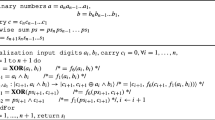Abstract
The first half of this paper is the written version of the invited talk presented at Unconventional Computing UC10, The University of Tokyo, Japan, June 21–25, 2010. It describes some salient features of hypercomputation in Dickson algebras. Such quadratic algebras form an appropriate framework for nonlinear computations which does not limit a priori the computational power of multiplication. They underlie paradoxical mathematics whose potential interest to analyse some computational aspects of the human mind which resist the classical approach is presented. In its last part, the paper offers new glimpses on the organic logic for hypercomputation by developing a fresh look at plane geometry in relation with the ζ function.

Similar content being viewed by others
Abbreviations
- SVD:
-
Singular Value Decomposition
- FTA:
-
Fundamental Theorem of Algebra
- iff:
-
if and only if
- IFS:
-
Iterated function system
- MGG:
-
Matrix graph grammar
References
Atkins R et al (2010) A characterization of hyperbolic iterated function systems. Topol Proc 36:189–211
Baez J (2001) The octonions. Bull AMS 39:145–205
Barnsley M (1988) Fractals everywhere. Academic Press, San Diego
Berry G (2009) Penser, modéliser et maitriser le calcul informatique. Collège de France/Fayard, Paris
Berthoz A (2009) La simplexité. Odile Jacob, Paris
Blair D (2000) Inversion theory and conformal mapping. Student Mathematical Library, Providence
Calude C, Chatelin F (2010) A dialogue about Qualitative Computing. Bull EATCS 101:29–41
Calude C et al (2010) The complexity of proving chaoticity and the Church–Turing thesis. Chaos 20:037103
Chaitin-Chatelin F Computing beyond classical logic: SVD computation in nonassociative Dickson algebras. In: Calude C (eds) Randomness & complexity, from Leibniz to Chaitin. pp 13–23 World Scientific, Singapore, (2007)
Chatelin F (1993) Eigenvalues of matrices. Wiley, Chichester
Chatelin F (2010) Numerical information processing under the global rule expressed by the Euler–Riemann ζ function defined in the complex plane. Chaos 20:037104
Chatelin F (2011) Qualitative computing, a computational journey into nonlinearity. World Scientific, Singapore
Conway J, Smith D (2003) On quaternions and octonions. A. K. Peters, Natick
Dickson L (1912) Linear algebras. Trans AMS 13:59–73
Dickson L (1923) A new simple theory of hypercomplex integers. J Math Pures Appl 2:281–326
Douillet P (2009) Pencils of cycles in the triangle plane. Working Paper ENSAIT, University of Lille
Eakin P, Sathaye A (1990) On automorphisms and derivations of Cayley–Dickson algebras. J Algebra 129:263–278
Gutzwiller MC (1990) Chaos in classical and quantum mechanics. Springer, Berlin
Hurwitz A (1919) Vorlesungen über die Zahlentheorie der Quaternionen. Julius Springer, Berlin
Jordan C (1874) Mémoire sur les formes bilinéaires. J Math Pures Appl 19(Série 2):35–54
Klein E (2005) Chronos: how time shapes the Universe. Avalon Publishing Group, New York
Mahler K (1943) On ideals in the Cayley–Dickson algebra. Proc R Irish Acad 48:123–133
Maxwell JC (1891) A treatise on electricity and magnetism, 3rd edn in 2 vols (republ. 1954). Dover, New York
Pérez Velasco PP, de Lara J (2009) Matrix graph grammars and monotone complex logics. ArXiv:0902.0850 v1 [cs. DM]
Pfieffer R, van Hook C (1993) Circles, vectors and linear algebra. Math Mag 66:75–86
Plouffe S (1998) The computation of certain numbers using a ruler and compass. J Integer Seq 1:article 98.1.3
Poincaré H (1898) On the foundations of geometry. Monist 9:1–43
Poincaré H (1902) La Science et l’Hypothèse. Flammarion, Paris
Poon C-S, Young DL (2006) Non associative learning as gated neural integrator and differentiator in stimulus-response pathways. Behav Brain Funct 2:29
Rumely R (1986) Arithmetic over the ring of algebraic integers. J Reine Angew Math 368:127–133
Schafer R (1954) On algebras formed by the Cayley–Dickson process. Am J Math 76:435–446
Schafer R (1966) An introduction to nonassociative algebras. Academic Press, New York
Ungar AA (1988) The Thomas rotation formulation underlying a nonassociative group structure for relativistic velocities. Appl Math Lett 1:403–405
Ungar AA (2001) Beyond the Einstein addition law and its gyroscopic Thomas precession. Kluwer, Dordrecht
Valaas L (2006) Triangles in hyperbolic geometry, e-manuscript, Senior project. Whitman College
Varičak V (1910) Anwendung der Lobatchefskjschen Geometrie in der Relativtheorie. Phys Z 10:826–829
Acknowledgements
The author wishes to thank the two referees whose constructive remarks led to a substantial clarification of the paper. She is grateful to C. Calude for inviting her to talk at UC2010 and to G. Chaitin for his words of encouragement.
Author information
Authors and Affiliations
Corresponding author
Rights and permissions
About this article
Cite this article
Chatelin, F. A computational journey into the mind. Nat Comput 11, 67–79 (2012). https://doi.org/10.1007/s11047-011-9269-6
Published:
Issue Date:
DOI: https://doi.org/10.1007/s11047-011-9269-6




